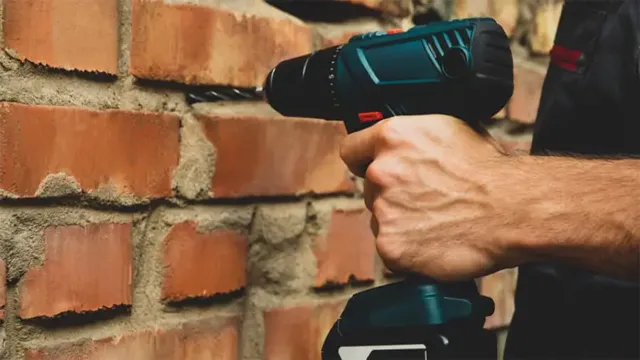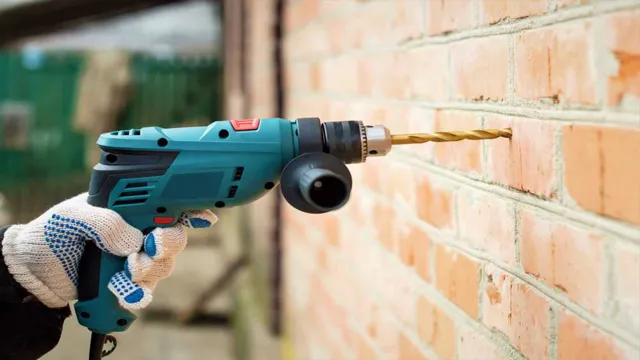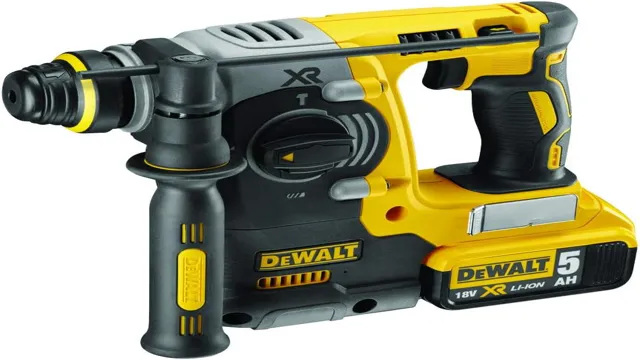Can a Cordless Drill Go Through Brick? Tips and Tricks to Get it Done

When it comes to DIY home improvement projects or repairs, a cordless drill is a must-have tool for many homeowners. These portable power tools are useful for a range of tasks, from hanging pictures to building furniture. But what about drilling through brick? Can a cordless drill handle such a tough material? The short answer is yes, but it depends on a few factors.
In this blog post, we’ll discuss what you need to know about using a cordless drill to drill through brick and provide tips to ensure success. So, whether you’re planning on installing a shelf or building a brick wall, read on to learn more.
Understanding Your Cordless Drill
If you’re wondering whether a cordless drill can go through brick, the answer is yes, it definitely can. However, it largely depends on the type of brick and the power of your drill. For instance, if you’re dealing with standard house bricks, most cordless drills will have the power needed to penetrate through them.
However, if you’re dealing with harder bricks like firebricks or dense masonry bricks, a more powerful drill would be needed. Additionally, using the right drill bit is essential, and a masonry bit is the best type to use for drilling through brick. It’s also important to ensure that you follow safety measures like wearing protective gear and avoiding twisting or forcing the drill bit in order to prevent any accidents.
Overall, a cordless drill can be a convenient and efficient tool for drilling through various materials, including brick, as long as you have the proper equipment and are aware of the limitations of your tool.
Power Voltage
Power Voltage If you’re in the market for a cordless drill, understanding power voltage is essential. Voltage determines the strength of the drill, and higher voltage typically means more power. The most common voltages for cordless drills are 12V, 18V, and 20V.
It’s essential to consider the tasks you’ll be using the drill for when selecting the voltage. For simple tasks like hanging pictures or assembling furniture, a 12V drill may suffice. But for more heavy-duty projects like drilling through thick metal or concrete, you’ll want a higher voltage drill.
Keep in mind that higher voltage drills also tend to be heavier, so you’ll want to balance power with your ability to comfortably operate the tool. Always check the manufacturer’s recommendations and safety guidelines before purchasing and using a cordless drill and consider investing in a quality battery for optimal performance.

Battery Capacity
Battery capacity is an essential aspect to consider when it comes to cordless drills. The capacity refers to the amount of charge the battery can hold and how long it can run before needing a recharge. For example, a battery with a capacity of 2 Ah should theoretically last longer than a 1 Ah battery.
However, this doesn’t necessarily mean that the higher capacity battery will last twice as long. Other factors like the type of work being done and the voltage of the drill also come into play. Furthermore, it’s also important to consider that batteries lose their capacity over time, so it’s crucial to properly maintain and store them.
Overall, understanding the battery capacity of your cordless drill will help you choose the right tool to get the job done efficiently, whether it’s for a home improvement project or professional use.
Drill Bit Size
If you’ve ever stepped into the hardware store to buy a drill bit, you’re probably no stranger to the confusion that comes with selecting the right size. With so many different options available, it can be challenging to determine which drill bit size will best match your cordless drill. But don’t worry, selecting the appropriate drill bit size is easier than you think.
The size of the bit you require will vary based on the type of project you’re working on. For instance, if you’re working on a wood project, you’ll need a drill bit that’s slightly smaller than the screw you’ll use to attach the material to avoid splitting your wood. On the other hand, if you’re working with tougher materials like metal or concrete, you’ll need a drill bit that’s specifically designed for those tasks.
So remember, to ensure that your drill bits are perfectly matched to your cordless drill, you must consider the type of material you’re working with before making a purchase.
Factors That Affect Drilling Through Brick
If you’re wondering whether a cordless drill can go through brick, the answer is yes, but there are several factors that can affect the success of your drilling. First and foremost, the type of drill bit you use is crucial. Brick is an extremely hard and dense material, so you’ll need a masonry bit that is specifically designed to drill through it.
You May Also Love:
The size of the bit also matters, as a larger bit may cause the brick to crack or even shatter. The power of your cordless drill is another factor to consider, as a weaker drill may struggle to penetrate the brick. Additionally, the condition of the brick can play a role, as older or weathered brick may be more difficult to drill through than newer brick.
Taking these factors into account when drilling through brick can ensure a successful and safe project.
Brick Type and Quality
When it comes to drilling through brick, the type and quality of the brick can play a significant role. Softer bricks made of lower quality materials are easier to drill through than harder bricks made of higher quality materials. Additionally, if the brick is old or has been exposed to moisture, it may become harder and more difficult to drill through.
Another factor to consider is whether the brick has been fired or not, as fired bricks are typically harder and denser than unfired ones. When choosing a drill bit for drilling through brick, it’s important to take these factors into account to ensure success and avoid damaging the brick. By selecting the proper drill bit and taking the necessary precautions, such as wearing protective gear and drilling at the correct speed and angle, anyone can successfully drill through brick.
Drill Bit Type and Condition
When it comes to drilling through brick, there are a few factors that can make the process more challenging. One of the biggest factors is the type and condition of the drill bit being used. Using a low-quality or dull drill bit can make it difficult to get through even a single layer of brick.
That’s why it’s important to invest in a high-quality drill bit that is specifically designed for masonry work. Additionally, the age and condition of the brick itself can play a role in how easy or difficult it is to drill through. Older, more brittle bricks can be especially challenging to work with, while newer, high-quality bricks can often be drilled through with relative ease.
By taking the time to assess these factors and choose the right drill bit for the job, you can ensure that your brick drilling project goes smoothly and yields the results that you’re looking for.
Drilling Technique
Drilling through brick can be a daunting task, but there are several factors to consider that can make the process smoother. One of the main factors is the type of drill bit being used. Carbide-tipped masonry bits are recommended for drilling through brick, as they are specifically designed to handle the hardness of the material.
The size and depth of the hole needed will also impact the drilling technique. It’s important to use a drill that is appropriate for the size and power needed for the job. It’s also important to ensure that the brick is securely in place and not loose, as this can cause the drill to slide or move off course.
Finally, taking breaks during the drilling process and periodically cooling the bit can prevent overheating and prolong the life of the drill bit. Keeping these factors in mind can make drilling through brick a successful and efficient process.
Steps to Follow When Drilling Through Brick
If you’re wondering whether a cordless drill can go through brick, the answer is yes, it can! However, the process requires special consideration and preparation. Firstly, you need to choose the right type of drill bit that can handle the hardness of the brick. A carbide-tipped masonry bit would be your best bet in this case.
Next, mark the point where you want to drill the hole on the brick, and ensure that it’s level and straight. Then, put on your safety goggles and use a hammer drill function on your cordless drill to make the hole through the brick. Remember to apply a steady amount of pressure and keep the drill bit lubricated with water to prevent overheating.
Once the hole is completed, clean it out and insert the appropriate anchor or screw. With these steps, you can successfully drill through brick with your cordless drill.
Step 1: Mark Your Spot
If you’re planning on drilling through brick, it’s important to follow certain steps to ensure a successful outcome. Step one involves marking your spot on the brick where you want to drill. This may seem like a no-brainer, but it’s crucial to get it right.
Take a pencil or marker and make a small dot on the brick. Make sure it’s in the exact spot you want to drill and that it’s level. If you’re drilling multiple holes, take the time to measure and mark each one individually.
This will save you from making mistakes and potentially damaging the brick. By taking the time to accurately mark your spot, you’ll have a better chance of drilling straight through the brick and achieving the desired outcome. Remember, precision is key when it comes to drilling through brick!
Step 2: Use Masonry Bit
When drilling through brick, the second step is to use a masonry bit. This is different than a regular drill bit and is specifically designed to drill through tough materials like brick and concrete. Masonry bits typically feature a carbide tip that is embedded in the drill bit itself.
Carbide is a very hard material that can withstand the high levels of heat and friction that are generated when drilling into dense materials. When using a masonry bit, it’s important to choose the right size for the job at hand. If the bit is too small, it won’t be able to create the necessary hole size, and if it’s too large, it could cause the brick to crack or break.
By selecting the proper size and type of masonry bit, you can ensure a clean and safe drill through the brick.
Step 3: Apply Light Pressure
When drilling through bricks, it’s crucial to apply light pressure to avoid damaging the material. One key mistake people make is using excessive force, assuming that this will speed up the drilling process. However, this approach is counterproductive, as it can lead to cracks and deformities in the brick.
Instead, it’s important to drill at a steady pace, using a light, consistent pressure. Start by making a small indentation in the brick with the tip of the drill, gradually increasing the pressure as you go. Remember to take breaks and let the drill bit cool down periodically, as the heat generated during drilling can also cause damage to the brick.
By taking your time and using a gentle touch, you can effectively drill through bricks without causing any unnecessary harm.
Step 4: Keep Cool and Go Slow
When it comes to drilling through brick, it’s important to keep cool and go slow. Brick is a tough material, and rushing through the drilling process can result in cracking or damaging the brick. Start by creating a guide hole with a masonry bit, and then gradually increase the size of the hole with larger bits.
Make sure to keep the drill bit perpendicular to the wall, and avoid applying too much pressure that could cause the brick to crack. Additionally, it’s important to use a drill with a variable speed setting and to take breaks to avoid overheating the drill or bit. By taking your time and staying patient, you’ll be able to successfully drill through brick without any damage.
Remember to always wear safety goggles and gloves, and to use caution when handling power tools.
Step 5: Use Hammer Function If Needed
When it comes to drilling through brick, the hammer function can come in handy. It is especially useful if the brick is particularly thick or tough. Before using the hammer function, make sure you have the appropriate drill bit and protective gear to avoid any accidents.
The hammer function creates a percussive force, which helps to break through the dense brick material. When drilling, apply constant pressure and avoid adding too much force as this can damage the drill bit or even the brick itself. After drilling through the brick, take a moment to inspect the hole and make any necessary adjustments to ensure it is clean and smooth.
By following these steps and using the hammer function judiciously, you should be able to drill through brick with ease.
Conclusion
In conclusion, while a cordless drill may technically be capable of drilling through brick, it would be like trying to use chopsticks to cut through a steak. Sure, it’s possible, but it’s not the right tool for the job. For optimal results, it’s always best to use the appropriate equipment for the task at hand, whether that be a hammer drill or a good old-fashioned chisel and hammer.
Remember, a job worth doing is a job worth doing right!”
FAQs
What is the best type of drill bit to use for drilling into brick with a cordless drill?
For drilling into brick with a cordless drill, it is recommended to use a masonry bit that is specifically designed to handle the harder material.
How much power should a cordless drill have to drill into brick?
It is recommended to have a cordless drill with at least 18 volts of power when drilling into brick to ensure enough torque to handle the harder material.
Can all cordless drills successfully drill into brick?
Not all cordless drills have the power and torque necessary to drill into brick. It is best to choose a drill with enough power and the correct drill bits.
Is it necessary to use water when drilling into brick for dust control?
Yes, it is recommended to use water when drilling into brick to prevent dust inhalation and ensure safety.
Can a cordless hammer drill be used for drilling into brick?
Yes, cordless hammer drills are designed for masonry work and can be used for drilling into brick.
What safety precautions should be taken when drilling into brick with a cordless drill?
Safety goggles, a dust mask, and ear protection should be worn during drilling. It is also important to secure the brick and start drilling slowly to avoid any accidents.
Are there any tips for drilling into brick more easily with a cordless drill?
Using a sharp drill bit and applying consistent pressure can help make drilling into brick easier. It can also be helpful to use a guide to ensure precise holes.



